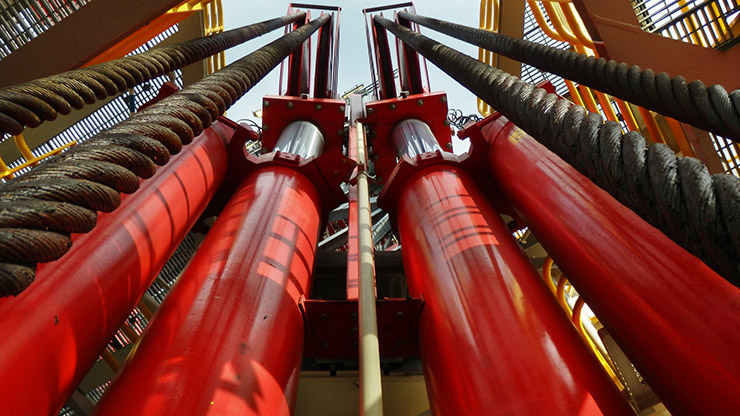By Eric Bucci, Oil & Gas Segment Manager, Trelleborg Sealing Solutions
and Beth Figliulo, Fluid Power Segment Manager, Trelleborg Sealing Solution
 The tensioner cylinders used to support subsea production risers where they connect to the rig are the size of an 18-wheeler. These components are in motion 24/7, and must accommodate 50-foot strokes during storms. With a cost of up to $100,000 to ferry one onshore for refitting and return it to the rig (not including lost production costs), it’s little wonder that rig operators insist every cylinder they install last at least 10 years.
The tensioner cylinders used to support subsea production risers where they connect to the rig are the size of an 18-wheeler. These components are in motion 24/7, and must accommodate 50-foot strokes during storms. With a cost of up to $100,000 to ferry one onshore for refitting and return it to the rig (not including lost production costs), it’s little wonder that rig operators insist every cylinder they install last at least 10 years.
That’s a tall order for the seals contained within the system — not only because of the wear requirements, but also due to the water glycol fluids used in offshore systems. The fluids are more environmentally friendly than oil-based HLP fluids, but they exhibit low lubricity properties, which is detrimental to many seal materials, including rubber.
Redundancy and wear-resistant materials
Successfully creating a sealing system that meets the requirements of an offshore tensioner cylinder involves deep experience with systems of this type, seals and wear rings composed of high-performance materials that are compatible with water glycol fluids, and inclusion of a secondary seal.
Key considerations for the primary seal include wear life, lubricity, and fluid compatibility. A highly wear-resistant seal material is essential to ensure the seal system is leak-free for as many years as possible. However, the seal must also be able to move constantly within the water-based fluid system with as little friction as possible — and withstand the aggressive chemicals used to inhibit corrosion.
Seals composed of rubber-based materials do not perform well in these types of systems. They are prone to compression set and chemical attack, and their friction rate is higher than polytetrafluoroethylene (PTFE) or polyethelene (PE)-based seals. The primary seals in tensioner systems are typically composed of PTFE or PE variants and are the first line of defense against leakage.
The secondary seal, which must perform in dry environments for years, is typically a PTFE-based seal, due to its inherent lubricity and ability to resist wear at high temperatures. Even though the cylinders operate at ambient temperatures, the seal friction when running dry can generate heat, and the seal material must be able to resist this. In real-world environments, PTFE seals have performed very well when put to use as a secondary seal, ready to operate in an event of a primary seal leakage.
Early warning systems
Beyond the primary and secondary seals, a successful offshore hydraulic cylinder system must include robust filtration, an early warning system to alert operators to a leak, and high-performance wear rings to prevent rod deflection.
Although environmental seals with scraping elements are included in every tensioner cylinder, fluid cleanliness is essential for a long system life. Particles and sand can exist in a hydraulic system during the fabrication process. These must be filtered out to avoid damaging the primary seal. Operators with any questions regarding necessary filters or the degree of cleanliness required to avoid seal damage should consult with the seal manufacturer.
Early warning systems are in place on virtually every rig to prevent a catastrophic event. In the case of tensioner cylinders, this consists of an evacuation port with a sensor, either between the primary and secondary seals or downstream of the secondary seal. If the sealing system fails, fluid goes first into the port, which alerts the operator to the leak so the system can be shut down.
Millions of pounds of force are placed on tensioner cylinders as they work to hold the riser in place. That force creates side loads, which in turn can cause rod deflection. To prevent that deflection and the resulting metal-to-metal contact, high quality wear rings should be used to keep the rod centralized in the bore. The wear rings are made from a water- and wear-resistant fabric/resin composite for maximum load capability and minimal wear characteristics.
There are several crucial questions offshore operators should ask about potential seal systems for tensioner cylinders:
1. What seal material is used for the primary and secondary seal? (Some old-school systems use stacks of seals to provide redundancy, but the seals are typically rubber-based and are thus prone to compression set, chemical attack, and high friction.)
2. Have the seal materials being used been tested to ensure they are compatible with the chemicals that will be used in the hydraulic fluid?
3. How long has the seal system lasted without leakage in real-world situations?
4. What level of filtration is required to ensure that seals within the hydraulic system are not damaged?
Seal selection for tensioner cylinders centers around three main criteria. First, the primary seal must be highly wear resistant, able to perform well in low lubricity water glycol fluids, and compatible with the chemicals used in the fluid. Second, the secondary seal must be able to run dry for up to 10 years without degrading to provide redundancy should the primary system fail. Third, both seals should be proven to perform as specified in real-world situations to ensure the rig operator will not incur the high cost of bringing the cylinder onshore to refit the seal system.
Filed Under: Fluid Power World Magazine Articles, Sealing